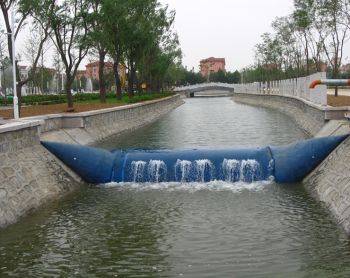Rubber Dams
From ASDSO Dam Safety Toolbox

|
| An example of an inflatable rubber dam.
(Image Source: Wikipedia) |
Rubber dams are inflatable, cylindrical dams placed across channels that act as a weir or dam to raise the upstream water level when the structure is inflated. They are typically made of a rubberized fabric membrane. Stainless steel mesh or ceramic chips can be embedded in the membrane to hinder vandalism. They can be filled with water, air, or both. Rubber dams are normally used to temporarily increase storage at existing dams, divert water for irrigation, provide flood control, or provide a reservoir for recreation.
Examples
Best Practices Resources
Revision ID: 7307
Revision Date: 07/18/2023
